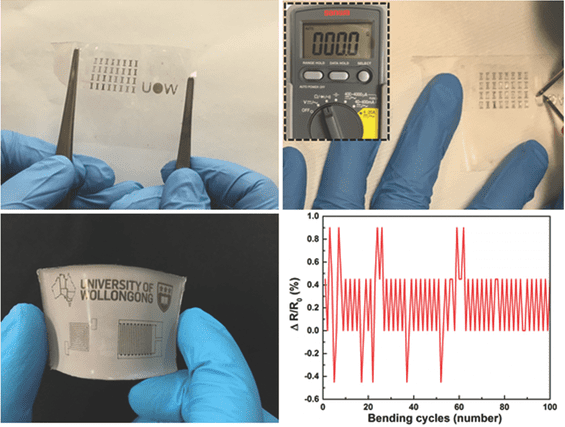Superconductors have attracted researchers for many years, as these materials show a superior current density and no electrical resistance loss, as well as a strong quantum-size oscillations effect, which make them highly suitable for building high-speed micro/nanoelectronics devices. However, the processing complexity, as well as the high manufacturing costs, limit the usage of superconducting materials in devices. Due to their rigidity and bad connectivity, high-temperature superconductors, such as MgB2, pnictides, and cuprates, are extremely difficult to incorporate into flexible micro/nanodevices. The brittleness is also a serious issue in the application of superconductive materials in flexible devices.

Conductive patterns printed with an EGaInSn-based ink onto flexible substrates.
A team of researchers from the University of Wollongong, Australia, the Xiangtan University and Beihang University, China, have developed a family of superconducting liquid metals of GaInSn-alloys and their nanodroplets. By tuning the composition of the alloy, a critical temperature of 6.6 K was obtained for superconductivity. By using organic stabilizing agents, the nanoparticles can be stabilised and dispersed in a wide variety of solvents. Not only the liquid metal nanodroplets retain their bulk superconducting properties, they can also be used as inks for various printing techniques.
The researchers have fabricated stretchable and flexible superconductive devices, such as microsized superconductive coils, electric circuits and superconductive electrodes on commonly used polyethylene terephthalate (PET) and polydimethylsiloxane (PDMS) substrates.
By enhancing the critical temperature for superconductivity for GaInSn-alloys above 4.2 K, which is the liquid helium critical point, the authors foresee that these materials can become a practical candidates for micro/nanosuperconducting electronics. Moreover, the nontoxic nature of the alloys allows them to be practically and safely used for flexible, low-cost, and lightweight micro/nanoelectronic devices. Further applications may be energy devices, microelectromechanical systems, NMR, sensors, and display devices.
















